Chinese Name: 宽窄巷子 Pronunciation: Kuān Zhǎi Xiàng Zi
English Name: Kuanzhai Alley (Kuanzhai Xiangzi)
Suggested Visiting Hours: 5 Hours
Building Area: About 79 acres
Building Time: 1718
Building Function: Residential area and commercial district
Best Visiting Season: Spring, Summer, and Autumn
Admission Ticket Fare: Free of Charge
Opening Hours: 24 Hours
Address: Near Changshun Street of Qingyang District, Chengdu City, Sichuan Province
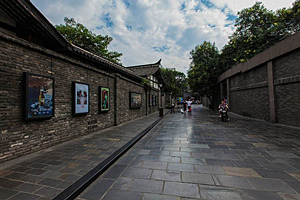
Kuanzhai Alley is composed of Wide Alley, Narrow Alley, and Jing Alley arranged in parallel. It is an antique courtyard with the bricks and tiles of the Qing Dynasty. It is located near Changshun Street, Qingyang District, Chengdu, Sichuan Province. It is a relatively large scale of the Qing Dynasty ancient street leftover in Chengdu.
Kuanzhai Alley starts from Zhijishi Street in the north, Jinhe Street in the south, Changshun Street in the east, and Tongren Road in the west. It covers an area of nearly 79 acres, including the core protection zone and the environmental coordination zone. Among them, the core protection area is located in the two neighborhoods of Wide Alley and Narrow Alley, south of Zhijishi Street and north of Jing Alley, covering an area of more than 13 acres; the remaining area which is more than 33 acres is an environmental coordination zone.
Kuanzhai Alley is an AA-level tourist attraction in China. It has won the titles of Chinese characteristic commercial pedestrian street, historical and cultural street in Sichuan Province, one of new ten scenic spots in Chengdu, and one of ten most beautiful streets in Sichuan.
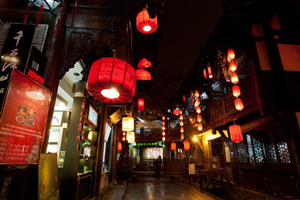
In the fifty-seventh year of Emperor Kangxi(1718), after the Jungar Rebellion was settled, more than a thousand soldiers were selected to station in Chengdu, and Mancheng was built on the basis of the old town. Only the Eight Banners of Manchu and Mongolian lived in Mancheng in the Qing Dynasty. After the fall of the Qing Dynasty, ManCheng was no longer a forbidden area, and the people were free to come and go to the town.
Some foreign merchants took advantage of the opportunity to open pawn shops near Mancheng and purchased a large number of houses and yards from local people. Therefore, a unique pattern was formed in which the descendants of the Machu, high-ranking officials and traffickers, and pawns lived in the city. The Wide Alley here was called Xingren Hutong, the Narrow Alley is called Taiping Hutong, and the Jing Alley is called Ruyi Hutong.
After the Revolution of 1911, Zhao Erfeng, the governor of the Qing Dynasty, then handed over his power and demolished the walls of Shaocheng. Some high-ranking officials came here to set up mansions and private houses. Yu Youren, Tian Songyao, Li Jiayu, Yang Sen and Liu Wenhui settled here one after another. Jiang Jieshi once came to settle here, too. Therefore, these ancient buildings have been preserved. In the early years of the Republic of China, the city managers at that time changed the name "hutong " to "alley ".
In the 37th year of the Republic of China (1948), during an urban survey, it was said that after the measuring, the staff at that time marked the wider alley as "wide alley" and the narrower one was "narrow alley". The one with a well is the "Jing Alley.”
After the founding of the People’s Republic of China, houses were allocated to nearby state-owned companies for the accommodation of workers, and houses were redistributed during the Cultural Revolution.
In the 1980s, Kuanzhai Alley was included in the "Chengdu Historical and Cultural City Protection Plan."
In 2003, the main reconstruction project of the historical and cultural area of Kuanzhai Alley in Chengdu was established. On the basis of protecting the real buildings of old Chengdu, a complex cultural commercial street with distinctive regional characteristics and strong Bashu cultural atmosphere was formed. At last, Kuanzhai Alley is created into a "Tianfu Shaocheng" with the connotation of “old Chengdu”.
In 2005, the project of the reconstruction of Kuanzhai Alley was launched.
On June 14, 2008 (the third Chinese cultural heritage day), as a landmark event in Chengdu's tourism recovery after the earthquake, Kuanzhai Alley was opened to the public.
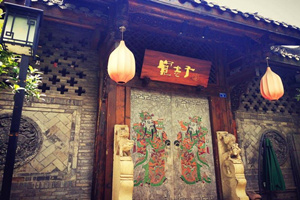
Wide Alley is a nostalgic zone with an old face. Wide Alley was named Xingren Hutong during the Xuantong period of the Qing Dynasty. There are many buildings in the Narrow Alley from the end of the Qing Dynasty to the beginning of the Republic of China, including some Western-style buildings left by the church. Wide Alley is a "leisure life" area, a reproduction of life in old Chengdu. There is an old Chengdu life experience hall on the Wide Alley, where the local customs and old Chengdu folk customs are all here.
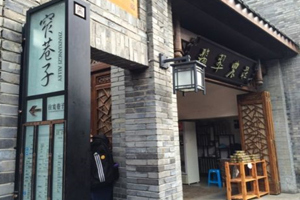
The Narrow Alley is the "slow life" area, which displays the courtyard culture of old Chengdu. Most of these courtyards are occupied by stylish bars and restaurants. Tourists and young people stay in the alleys and enjoy the whole afternoon leisurely.
The Narrow Alley is an exquisite lifestyle area with the theme of various western-style dining, light dining, coffee, art and leisure, healthy living hall, and characteristic cultural theme stores.
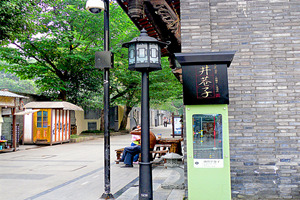
Jing Alley is the reappearance of the scene of an old city in Chengdu. Jing Alley is adjacent to the south of Narrow Alley, named Ruyi Hutong, or Mingde Hutong in the Qing Dynasty. After the Revolution of 1911, it was renamed "Jing Xiang Zi". The Jing Alley is located on the remaining half of the street. A 500-meter-long brick cultural wall and a 500-meter-long folk photo wall were built on the other side of the street.
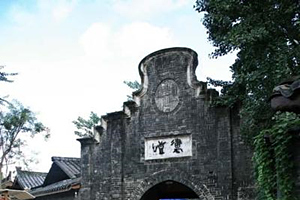
Kailu is located at No. 11 of Wide Alley. The courtyard is named Kailu. This gate is one of the most iconic gates in Kuanzhai Alley. The courtyard gate is built with special blue bricks to form an arched gate with a curved shape. A Chinese traditional stone plaque is embedded above the door hole. The plaque adopts a large seal carved "Kailu". The two-character writing method is innovative which can reflect the reading rule at that time-reading from right to left. The oval pattern is built on the top of the stone plaque which represents a high-hanging "evil-shielding mirror", which is intended to drive away all kinds of monsters and keep the family safe forever.
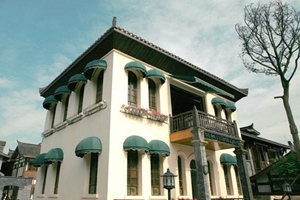
The small western-style building is located among the Kuanzhai Alley. It is the characteristic with Roman columns, western-style arched doors and windows, large five-star decorations on the window lattices. Legend has it that in the 1930s, one soldier surnamed Wang bought this courtyard with foreign buildings. During the Anti-Japanese War, the soldier was called to the front and never returned. In this small western-style building, his wife has been waiting for her husband to come back until her death.
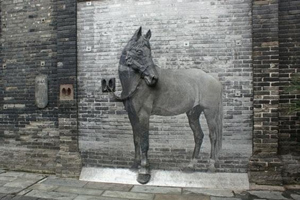
Shuan Ma Stone is located on the old wall at the gate of No. 32 in the Narrow Alley, about 1.2 meters above the ground. It has been weathered and mottled, and it is one of the only three horse-locking stones left in Kuanzhai Alley. A hundred years ago, it was the residence of the Eight Banners and their families in the north of Man and Mongolia, and they have the habit of riding horses. The Shuan Ma stone is a symbolic expression of northern culture in western Sichuan.
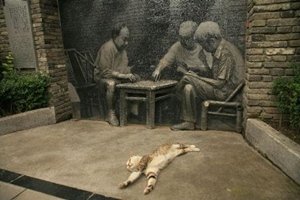
Brick Cultural Landscape Wall is a 400-meter-long sculpture wall in the Well Alley. It is the first museum in China to use bricks as a carrier. Pieces of old bricks with different historical sections are built into a platform through artistic creation. The historical and cultural fragments of Chengdu, such as the city, the wall, the road, the stele and the gate, illustrate the thousand-year-old Chengdu and have a history of more than 100 years.
The western part of the cultural wall, which ranges from "Baodun Remains City, Jinsha Zhu ni" to "Yangzi Adobe and Qin City Wall", and then from "Han Brick Relics, TangJian Luo City" to "Song Brick Road, Destroyed City at the End of Ming Dynasty", shows the vicissitudes of Chengdu's history.
Kuanzhai Alley is near Tian Fu square and People’s Park and you can take bus 5, 13, 43, 47, 58, 64, 78, 81 and get off at the Jinhelu Station. You can also take bus 62, 70, 93, 163,340 and get off the bus at the Chuang Shun Shang Street Station.
By Subway
You can take the subway line 4 to the station of Kuanzhai Alley.
By Taxi
Chinese: 请带我去宽窄巷子。English: Please take me to Kuanzhai Alley.
If you go to Kuanzhai Alley from Chengdu Railway Station, it takes about 23 minutes (22yuan ).
If you go to Kuanzhai Alley from Chengdu Shuangliu Airport, it takes about 60 minutes (74 yuan).
If you go to Kuanzhai Alley from Chengdu South Station, it takes about 30 minutes (35 yuan).
If you go to Kuanzhai Alley from Chengdu East Station, it takes about 40 minutes (30 yuan).
